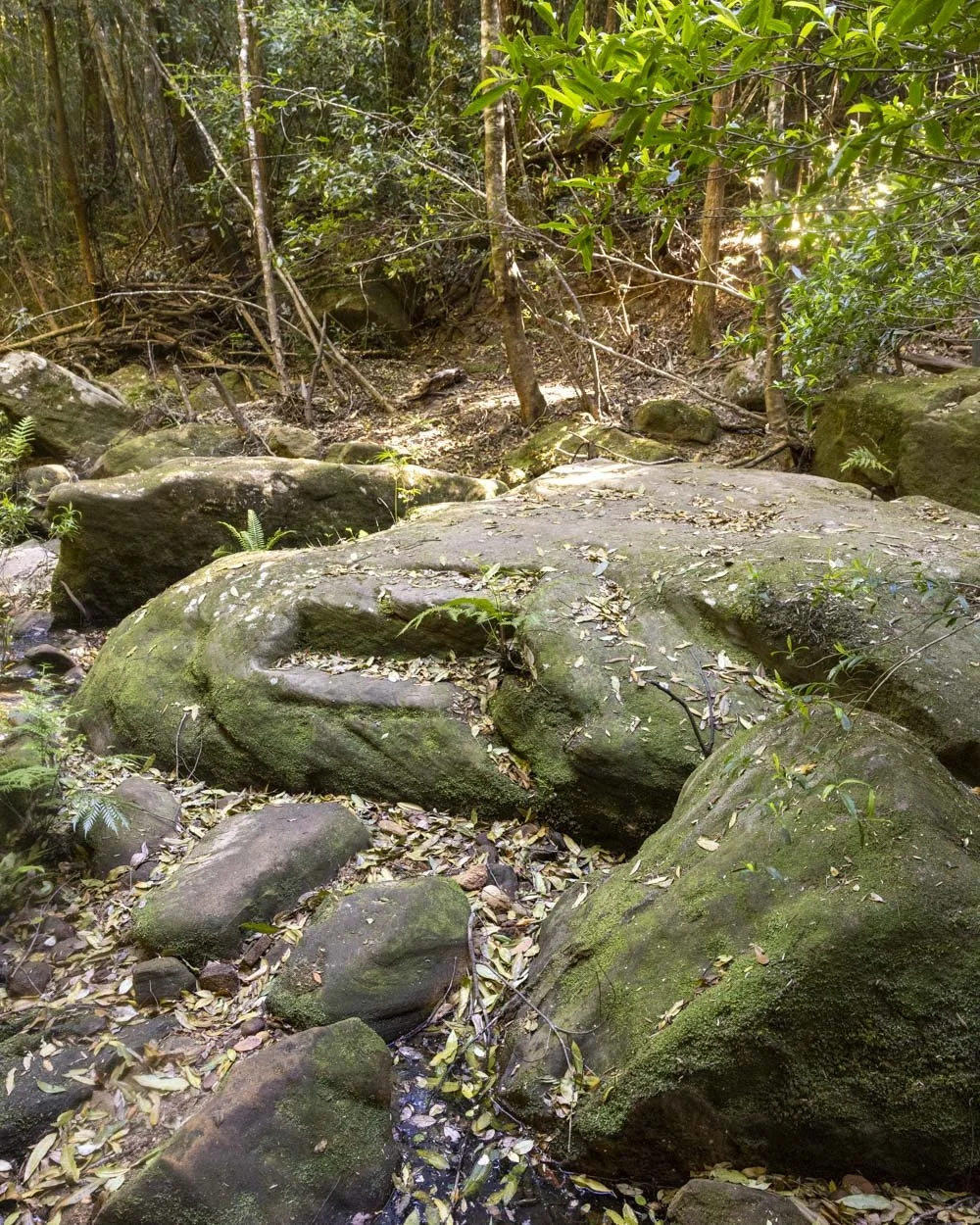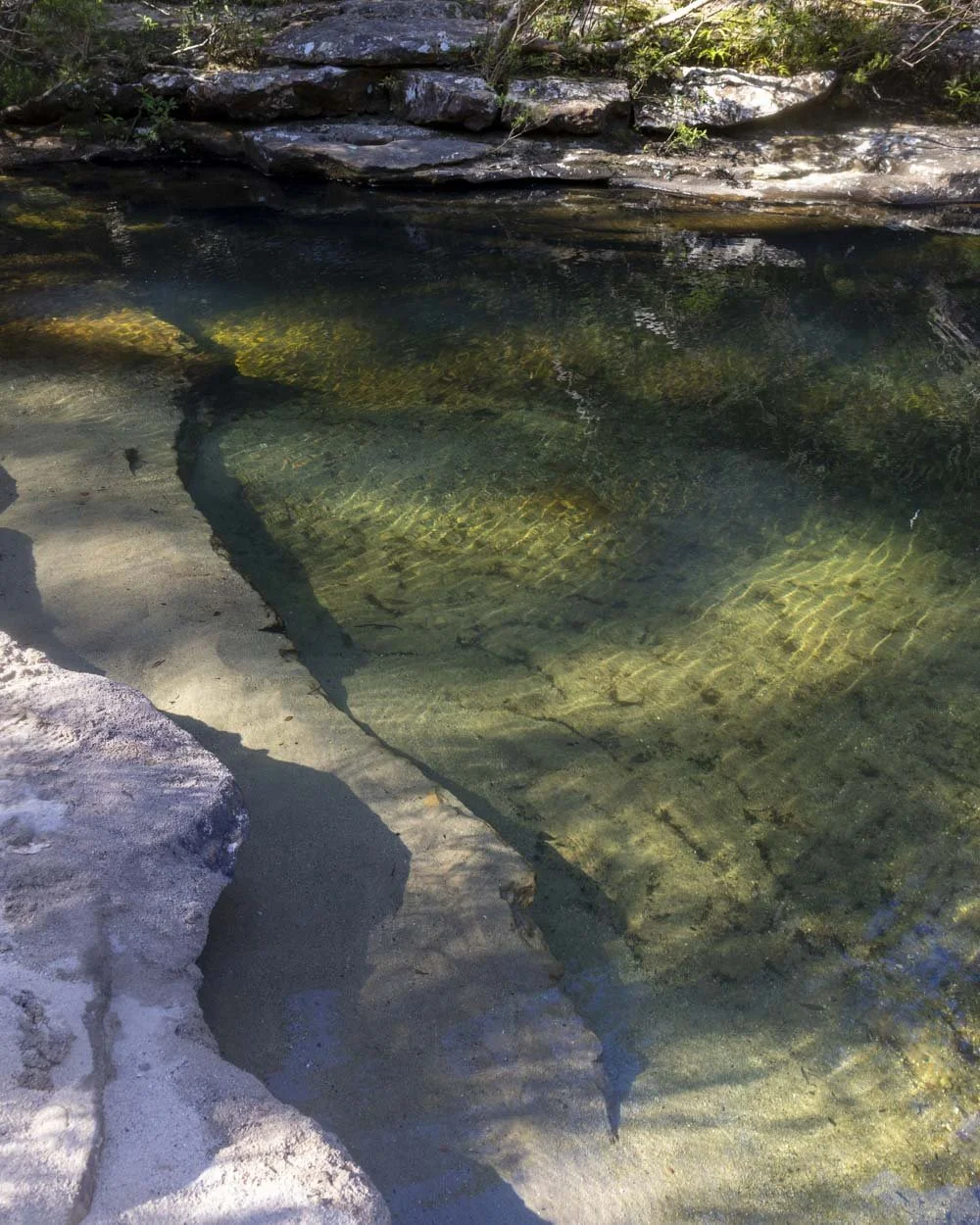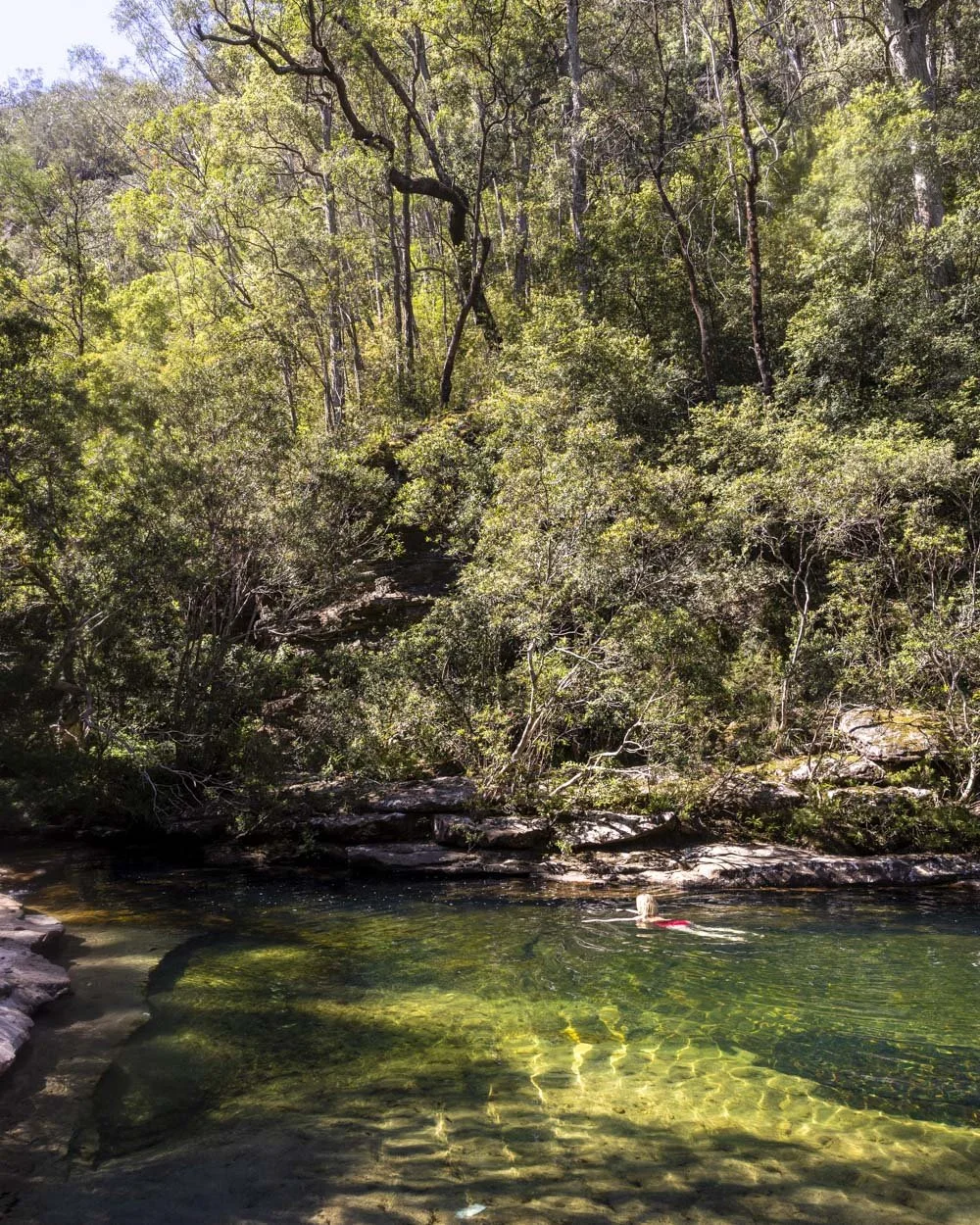Surrounded by gum trees with shimmering green water and a tiny sandy beach, it’s hard to believe Springwood Lagoon isn’t more well known. Hidden deep within the Sassafras Gully, it’s a beautiful spot with a mix of shallow and deep water, perfect for all the family.
It’s quiet and tranquil, but for the occasional plane flying overhead.
There are a couple of ways to access the lagoon, we’re sharing the quickest route which takes you through a shady gully lined with picturesque overhangs.
Here’s what to expect on the trail.
The walk to Springwood Lagoon
The stats
Distance: 3.6km return
Elevation gain: 200m
Difficulty: Moderate
Trailhead: Wiggins Track, Yondell Avenue in Springwood
Summary: There are a couple of ways of reaching Springwood Lagoon: our route via the Wiggins Track is the quickest, but you could also walk along the Sassafras Gully Track. The lagoon is 3.05km from the start of the Sassafras Gully Track and this is a great option if you want a longer walk which includes two gorgeous waterfalls.
Via the quickest route along the Wiggins Track, you will walk downhill much of the way to the lagoon. The trail is in fairly good shape, though much of the terrain is uneven, including rocks and tree roots.
The final few hundred metres to the lagoon is on a gentle gradient and this bit would normally be easy, however, at present (it may change over time) there are two notable blockages in the form of trees down over the track.
One of these is very significant and requires bypassing the debris via a makeshift path with some loose soil.
Starting the trail: descending through the bush
From the car park on Yondell Avenue you’ll follow the Wiggins Track downhill into the bush. The descent begins almost immediately and at first it is in dry bushland.
There are some uneven stone steps and exposed tree roots, but grip is generally good.
After a couple of hundred metres you will reach some washed out gullies, but again, footing is still good. It’s not made up of loose slippery soil. You’ll encounter some minor debris, but nothing that’s difficult to step over.
The trail gradient slackens a little, but continues much in the same way until you reach a small bridge 350m after beginning the trail.
There’s a little bit of flat track and then you will enter a much more picturesque section of the walk.
Descending the gully
You will soon see the first little cave, right beside the path, but there are several much more impressive ones further along the track. You’ll also encounter a few short sections of flat track inbetween time spent descending a mix of rocks steps and dirt path.
The forest begins to get damper and more lush with various trickling cascades. Roughly 300m from the first little cave you’ll see a larger cave, just off track on the right side of the path.
You can climb into this one, although we didn’t as there was someone sat playing the guitar up there and we didn’t want to disturb them - we didn’t see another soul on the whole walk so it was quite the surprise to hear music drifting through the bush!
Just 50m beyond this cave there is a huge honeycomb-like overhang which is a real beauty. It’s less cave like than the more enclosed ‘guitar cave’ but the pattens in the rock are stunning. You can also catch a little glimpse of the mountains beyond a dense sea of gum trees.
Around 70m from this larger overhang there is a very short rougher section of track, it’s just a few steps, but there are no formed stairs - it’s more of a large step down on rocks.
You’ll continue descending on uneven stairs for another 35m before you reach a sandy gully.
This easy gully lasts for 50m before you begin walking on a dirt track beside the creek. Don’t be put off if the creek looks debris laden and murky, the lagoon bears no resemblance to the creek at all!
Reaching the lagoon
After just over 100m walking alongside the water and over a couple of very minor washed out gullies, you’ll have to cross the creek.
There used to be a bridge here but it’s long since washed away. You now have to rock hop and make a large step between two big rocks to get across. It’s pretty easy though and doesn’t require jumping.
You then have a brief (70m) climb on gently sloping track before you reach a signpost and the intersection with the Sassafras Gully Track. You’ll turn left here and now have 850m to go to reach the lagoon.
It’s a mix of gentle descent and flat ground and the shady forest is so peaceful. The last part of the walk would be easy (and hopefully will be in the future), but there are currently two significant patches of debris.
The first is 350m in and there is so much tree fall that you can’t climb through it. Instead you need to bypass it, either by going slightly downhill or uphill around it.
Both have worn social trails to use and we thought the lower route looked less steep and had less loose soil so chose that one.
You need to walk a couple of steps down some loose soil and then over some rocks to rejoin the main track. The upper route didn’t have the rocks, but had much more loose soil.
You’re then back on a good path for another 350m before you reach blockage number two. It’s smaller but necessitates climbing directly through the debris, which is a bit scratchy and requires care.
Once you’ve stepped through the mass of tangled bush and tree fall you have just 100m easy walking to reach the little makeshift campsite beside some prominent rock formations.
You’ll see a small signpost pointing you downhill to the left and you’re now just 50m from the lagoon.
Swimming at Springwood Lagoon
To reach the sandy access point to the lagoon you need to cross a small set of cascades. There are plenty of rocks to use as stepping stones, so this is a dry crossing in all but flood conditions.
You can then enter the lagoon straight off the sand and as the bottom of the pool is also sandy, it’s a smooth and easy entry point.
Much of the water is shallow, so it’s a lovely spot for children or if you simply want to relax in the shallows. As the pool is relatively large, there’s still a decent amount of it which is deep enough for a proper swim, so what ever you’re looking for, you’ll find it here.
There are little in the way of rocks inside the water and the dense bushy surrounds make for a really wonderful place to swim.
Although it lies right beside the Sassafras Gully Track, it’s always surprisingly quiet, maybe because it doesn’t feature on any signposts like Perch Ponds and the waterfalls do.
The pool gets a lot of sun so it’s really nice one to while away an afternoon and the late afternoon light in the forest on the way back is a real treat.
When you’re ready to leave the pool you do have a fairly hefty ascent back up to the car park, but there are overhangs to explore and smalls sections of flat track to take a breather on.
Keep them wild
Please remember to take all rubbish with you and keep these places wild and pristine - as with anywhere in the outdoors. It’s important to leave them exactly as you found them so they will remain beautiful for generations to come.
Litter tends to breed litter, so if you do spot any and are able to pick it up and dispose of it outside the area, it will go a long way to keeping the area clean.
Parking for and getting to Springwood Lagoon
To use the quickest route as outlined above you need to start at the small parking area on Yondell Avenue in Springwood. you can see it here on Google maps. There is room for a handful of cars to park here.
If starting on the Sassafras Gully Track you park on Sassafras Gully Road in Springwood, you can see the spot here on Google maps. The start of this track is 1.4km away from Springwood train station if coming by public transport.
Springwood is located roughly 30km and a 30 minute drive from Katoomba and 71km and just over an hour’s drive from Sydney.
This post may contain affiliate links, meaning at no additional cost to you, that we will earn a small commission if you click through and decide to make a purchase. This helps towards the costs of running our website. Thanks for your support.
















































